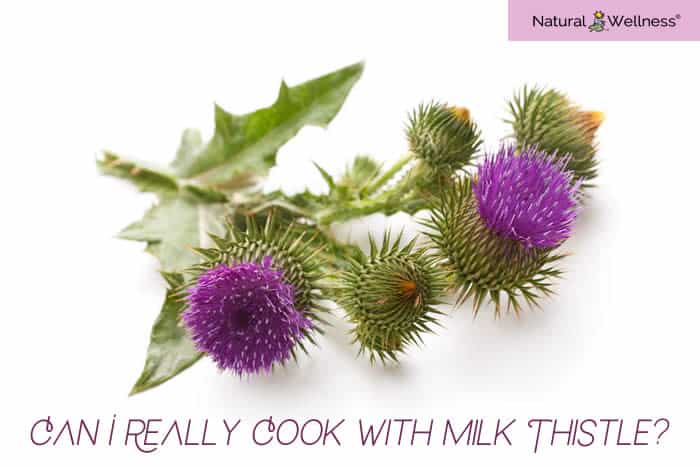

Milk thistle, a common weed in many places, is loaded with tons of health benefits. It is best known for improving liver health while fighting cirrhosis, jaundice, hepatitis, and gallbladder disorder, but it has many other benefits as well.
9 of Milk Thistle’s Other Benefits (1)
- Improved skin quality – When applied to skin, milk thistle has a potential antioxidant and anti-aging effect.
- Reduced cholesterol – Studies show it has helped lower cholesterol in those who take it
- Weight loss – When tested on mice, research found milk thistle caused them to lose weight.
- Reduced insulin resistance – This can help those with type 2 diabetes
- Helps fight allergies and asthma – Studies show it can help reduce inflammation in airways, making it easier to breathe.
- Fights the spread of cancer – A recent study showed that milk thistle reduced cell growth in colorectal cancer.
- Improved bone health – Studies show that it can help reduce bone loss.
- Better mental health – One study showed that milk thistle can reduce oxidative stress, which is a potential cause of Alzheimer’s.
- Healthier immune system – Studies reveal that it can help boost immunity and fight infections.
With all of these great qualities, it would behoove you to work milk thistle into your diet. While you can already get milk thistle in a supplement form, like Natural Wellness’s UltraThistle, did you know that you can also cook with it and integrate it into meals and snacks?
Below are some things you may want to know about eating milk thistle.
What Parts of Milk Thistle Are Edible?
In a nutshell, all of it! While you are most likely going to assume to just eat the leaves of the milk thistle, you can also eat the seeds, roots, stalk, and buds of the plant as well. The seeds are actually what are most full of nutritional silymarin compounds. (2)
What Can I Use Milk Thistle In?
Just like any leafy green, you can integrate milk thistle into any recipe that excites you.
Some examples include: (2)
- Juices and Smoothies – Just as some people like juicing celery or spinach, you can also juice milk thistle. Next time you make a smoothie with your favorite fruits or vegetables, throw some milk thistle in.
- Pies – Similar to spinach pies, you can make a milk thistle pie.
- Salads – Replace that lettuce or kale with milk thistle to change things up.
- Seasonings – Use some dried milk thistle to add some flavor to your next dish
- Soups – Consider working it into your chicken noodle soup the next time you’re not feeling so well. Ground up seeds will also help thicken it up.
- Vegetable Dishes – Some like baking it with lemon and oil, but it’s also been found to be tasty when battered and fried.
How Do I Prepare Milk Thistle?
Just as there are many ways to eat milk thistle, there are multiple ways to prepare its different parts. (2)
- Leaves – The leaves can be eaten raw, like spinach, and added to salads. Their stalks can also be eaten as a light snack.
- Seeds – You can ground the seeds into a powder and use them to make tea, soup or cereal. You can also use ground milk thistle seeds as a replacement for coffee. Or you can use the seeds to produce oil.
- Stalks – When boiled, the stalks can be used as a replacement for kale or cabbage and thrown into a nice soup. If you don’t want to boil them, you can also eat the stalks raw as a nice snack. Milk thistle stalks have also shown to help quench thirst. If you want to limit the bitter taste, it’s recommended to first peel the stalks and have them soak in water.
- Roots – You should only eat the roots that are about 1 to 2 years old. They can be enjoyed raw julienned, sliced, chopped, or shredded in a salad. The roots can be boiled or roasted for various recipes. Or they can be baked into a nice pie. Some have also found that once dried, they can be ground up into flour which can help thicken various soups and stews.
- Flower Buds – When you steam or boil the milk thistle’s buds, they can be enjoyed in a way similar to how you enjoy artichokes.
Are There Any Side Effects?
Milk thistle has been found to have relatively minimal side effects. In some cases though, it has been found to possibly cause diarrhea. In rare occasions it has been found to cause nausea, upset stomach, bloating and gas. Also, those who are allergic to ragweed should avoid milk thistle as it may cause an allergic reaction or rash. (3)
It is also recommended that women who are pregnant or breastfeeding should not be using milk thistle. Lastly, milk thistle has been found to possibly mimic the effects of estrogen. Thus, women with breast, uterine, or ovarian cancers should avoid milk thistle, as should women with endometriosis or fibroid tumors. (3)
Conclusion
So next time you are looking for a way to change things up in the kitchen and want to be a bit healthier – either to improve your liver or just for a better general well being – consider working some milk thistle into your cooking.
But if you want all of the benefits of milk thistle and may not have the time to cook, consider Natural Wellness’s UltraThistle. Its patented milk thistle formulation offers you 20 TIMES the protection and efficacy than all other milk thistle supplements of the same dosage. If you’re looking for a milk thistle supplement that will maximize your liver’s health and detoxification processes while rebuilding liver cells, then UltraThistle is the milk thistle supplement for you.




